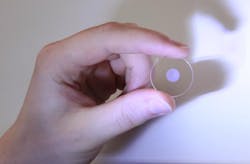Ultrafast-laser-written glass polarization converter inexpensively creates optical vortices
Southampton, England--Glass optical elements with vortex-shaped nanogratings developed by scientists at the University of Southampton's Optoelectronics Research Centre (ORC) can change a laser beam by creating optical vortices—a property valuable for superresolution optics and optical manipulation, among other applications.1
The prototype optical vortex converter, which works at a 532 nm wavelength, takes incident circularly polarized light and converts it to radially or azimuthally polarized light, depending on whether the incident light has left- or right-handed circular polarization; other polarization tricks are also possible. Azimuthally polarized light can be used at a focus to create a ring-shaped particle trap.
Fabrication by direct laser writing
The monolithic space-variant polarization converters are fabricated by direct writing with 270 fs pulses of light at a 1030 nm wavelength from a femtosecond laser, which spontaneously forms nanogratings in the glass with directions that are based on the polarization of the ultrafast beam. The gratings take the form of spiraling lines formed by strings of nanovoxels (volumetric nanopixels).
Previous research at the ORC showed that lasers with fixed polarization produce voxels consisting of a periodic arrangement of ultrathin (tens of nanometers) planes. By passing polarized light through such a voxel imprinted in silica glass, the researchers observed that it travels differently depending on the polarization orientation of the light. This "form birefringence" phenomenon is the basis of the new polarization converter. The advantage of this fabrication approach over existing methods for microscopy is that it is 20 times cheaper and it is compact.
"Before this we had to use a spatial light modulator based on liquid crystal which cost about £20,000," said Peter Kazansky, one of the researchers. "Instead we have just put a tiny device into the optical beam and we get the same result."
The researchers have also developed and adapted this technology for five-dimensional optical recording. "We have improved the quality and fabrication time and we have developed this five-dimensional memory, which means that data can be stored on the glass and last forever," said Martynas Beresna, lead researcher for the project. "No one has ever done this before." The researchers are working with the Lithuanian company Altechna to introduce this technology to the market.
REFERENCE:
1. Martynas Beresna et al., Applied Physics Letters 98, 201101 (2011).
About the Author
John Wallace
Senior Technical Editor (1998-2022)
John Wallace was with Laser Focus World for nearly 25 years, retiring in late June 2022. He obtained a bachelor's degree in mechanical engineering and physics at Rutgers University and a master's in optical engineering at the University of Rochester. Before becoming an editor, John worked as an engineer at RCA, Exxon, Eastman Kodak, and GCA Corporation.

